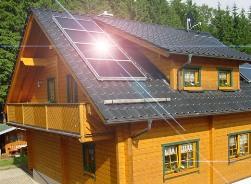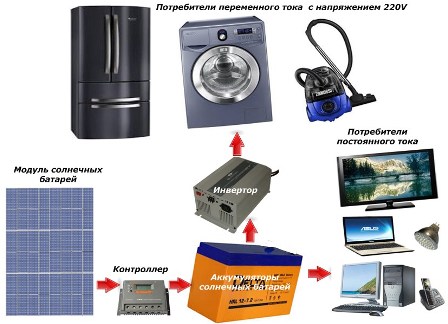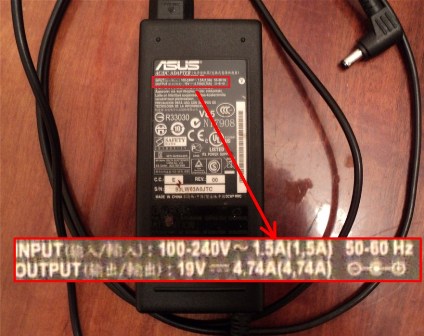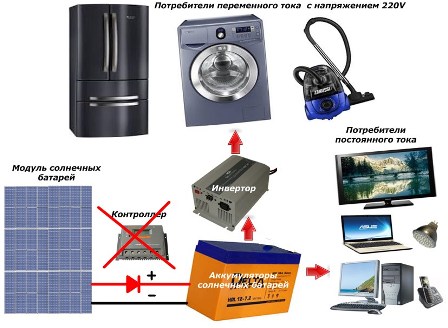Categories: Featured Articles » Autonomous power supply
Number of views: 57881
Comments on the article: 5
Solar Power For Home
How do solar power plants for the home. Tips for choosing a circuit and components
 Alternative sources of electricity are increasingly interested in homeowners. They are attracted by the low cost of using solar energy. But the mass introduction of devices operating from the solar light flux is constrained by the high cost of equipment and the complexity of its selection and installation.
Alternative sources of electricity are increasingly interested in homeowners. They are attracted by the low cost of using solar energy. But the mass introduction of devices operating from the solar light flux is constrained by the high cost of equipment and the complexity of its selection and installation.
In fact, to assemble with your own hands and operate a solar power station is within the power of a home master, even a senior student. To do this:
-
familiarize yourself with the principles of the scheme,
-
determine the tasks of the equipment,
-
choose the most suitable station equipment,
-
carry out mechanical installation of all elements,
-
assemble an electrical circuit
-
check performance and competently operate.
Numerous practical experiments allow us to recommend a universal scheme for solving the problems of a solar power plant for the home.
Typical scheme of a home power plant with a solar battery (click on the picture to enlarge):
It includes:
-
solar module based on individual photo cells,
-
controller,
-
electric energy storage batteries,
-
inverter.
It should be well understood that in a solar power plant, the role of solar panels is not in direct power supply to electrical consumers (although in certain situations this is justified: watches, calculators and similar devices), but in providing a charge for working batteries of the circuit, which:
-
receive electricity from solar modules,
-
accumulate it and pass it on to consumers.
The question of creating a home station should begin by determining its load. To do this, we need to analyze all consumers who will work from the energy of the sun. They are divided into two main classes:
-
devices operating on AC 220 V,
-
electronic and computer equipment, operating from a DC voltage of 12 / 24V.
Electric motors of refrigerators, washing machines, vacuum cleaners and other devices operate only from the ~ 220V / 50Hz network. They will have to be connected through a device that forms sinusoidal harmonics with the necessary characteristics from the constant power of the batteries. This device is called an inverter.
How it works and how to select it for certain loads is the topic of a separate article. And now it is important to understand that the output power of the selected inverter must ensure reliable operation of all consumers connected to it and even have a small margin.
In order to save, the alternate operation of alternating current consumers is quite acceptable. Agree that sometimes it is not necessary to turn on the washing vacuum cleaner to heat the water while the washing machine is running. It’s wise to wait until the wash is done, and then take a vacuum cleaner. This will significantly reduce the load on the inverter.
The transition to the use of a solar power station in the house should be combined with the replacement of lighting network devices. It makes no sense to spend the energy of the inverter on heating the filaments of incandescent lamps. They should be immediately abandoned, or in extreme cases switch to energy-saving lamps operating on voltage = 24 / 12V.
This will save you from unnecessary waste of energy because they, like the rest of the electronic and computer equipment, can be powered directly from the constant voltage of the storage batteries.
See what happens: the electronic circuit, for example, of a laptop is powered by battery power = 12V.
To recharge it, a power supply is used, which converts an alternating voltage of ~ 220V / 50Hz to a value of = 19V.
12 volts is enough for this laptop. Moreover, it is generally possible to remove the battery from it and feed directly from the storage batteries (battery). With this method, about 40% energy savings are created compared to the method of double conversion by an inverter and then a power supply.
Why additionally load the created design with unnecessary devices, meaninglessly warming the surrounding air with complex electronic devices? The power scheme of each household assistant must be well thought out and in a similar way to simplify its power supply. This will require very little cost:
-
pieces of wire
-
standard adapters.
In conclusion of such work, it will not be difficult to calculate the required output power of the inverter, and from it it is already possible to select the suitable model for purchase.
Now it's time to decide on storage batteries for your home solar power station. The rules of their choice and the main characteristics are not considered here - this is a voluminous separate topic, which will be discussed in detail in another article.
And now we will focus on the fact that these batteries should reliably power both consumer groups, which we briefly examined. Here, too, one should observe the order of operation of the devices and have some kind of reserve.
Having decided on the task of the batteries (their capacity and total output voltage), you can select the solar modules. Their modern production produces a large assortment with different manufacturing methods. They have different characteristics and capabilities.
Please note that solar modules:
-
according to the output voltage must correspond to storage batteries,
-
possess power capable of delivering a rated charging current to working batteries under medium lighting conditions.
There is another device in this circuit: controller. He works as an intermediary between solar panels and storage batteries, regulating the charge process.
Consider a simplified wiring diagram for a solar power station operating without controllers. This is done so that you have a clear understanding of its purpose.
A simplified diagram of a home power plant with a solar battery (click on the picture to enlarge):
In this circuit, the controller is removed, and an ordinary diode works instead. Why did you do that?
The controller’s only task is to recharge storage batteries up to 14–14.5 V. It does this in different ways and works periodically:
-
with increased solar activity,
-
lack of electricity consumption (batteries do not feed anything - do not need charging),
-
low battery capacity when they can not cope with the load and part of the energy to consumers comes from solar modules.
The full charge of the battery is performed by the MRPT controller, which scans the point with the maximum power output from the solar battery (see How are solar panels arranged and work?) This is the most reliable, but expensive design. Other models, especially On / Off developments, can be replaced with a power diode.
He will not allow the flow of batteries from the batteries to the solar battery in the dark, prevent their discharge. With this method, it is not recommended to leave the solar power station without load for a long time: the batteries will be recharged without any restriction, and we need to ensure a balance between charge and energy consumption. In this case, it is possible to exclude part of the solar battery from work or to switch additionally a constant load: ventilation, heating, lamps ...
Using a diode with a rejection of the controller reduces the cost of the circuit, but requires more careful monitoring and manual adjustments to the work.
In conclusion, pay attention to the most important thing in creating the design: all the elements of the home solar power scheme work in a complex, and therefore should be well selected and balanced among themselves and consumers.
The following articles will discuss the device and the principle of operation of controllers, inverters and batteries for home solar power plants.
See also: Solar batteries: how to pick up, operate and restore plates (desulfate)
See also at i.electricianexp.com
:




